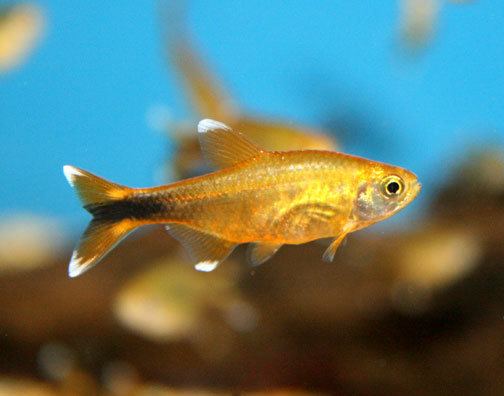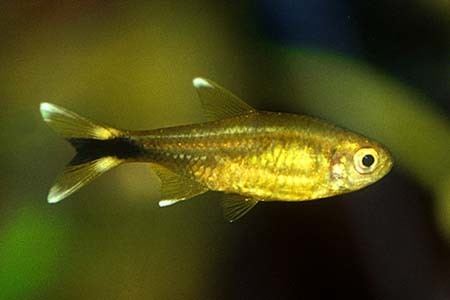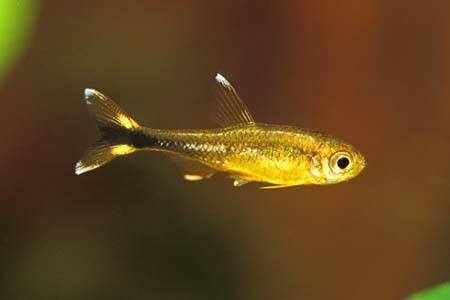Higher classification Hasemania | Phylum Chordata Scientific name Hasemania nana Rank Species | |
 | ||
Similar Hasemania, Hemigrammus erythrozonus, Black neon tetra, Flame tetra, Serpae tetra | ||
How to care for silvertip tetras hasemania nana silver tip tetra school size
Silvertip tetra (Hasemania nana) are freshwater tetra fish native to blackwater rivers in Brazil. Silvertip tetras are slightly more aggressive than other comparable smaller tetras, observed occasionally to nip other similarly sized tetras.
Contents
- How to care for silvertip tetras hasemania nana silver tip tetra school size
- Planted hardscape aquarium with silvertip tetra
- Description
- Distribution
- In the aquarium
- Nutrition
- Breeding
- Disease
- References

Planted hardscape aquarium with silvertip tetra
Description

The males have a copper color, the females are more pale and silvery. Both have white tips on the fins, hence the name. They differ from most other tetras by lacking a small second dorsal (adipose) fin. Silvertip tetras have a black area at the base of their caudal fin. The fish are transparent except for the fact that their bodies have an overall copper sheen. During the night, the copper and black become silver as the fish rests — the color is reactivated once the fish becomes active in the morning. It grows to approximately 3 cm (1 in) in overall length. Other than coloration, sexual dimorphism is slight, the female having a very slightly larger belly.
Distribution
Silvertip tetras are found in blackwater rivers in Brazil.
In the aquarium

Silvertip tetras prefer a densely planted aquarium, with a dark substrate. They are a shoaling fish and prefer a space in the center for swimming room. The fish come from very soft and acidic waters and when these conditions are met, their colors become more vivid. They tend to occupy the middle level of the aquarium. While tank-bred silvertips have adapted well to a wide range of water conditions, in the wild they inhabit very soft, acidic waters. Silvertips have a lifespan of about three years.

Silvertip tetras are considered moderately easy to keep in a community aquarium with a pH of 6.0 - 7.5. However, they will not tolerate dramatic changes to their environment. They tend to be moderately aggressive and, because of their small size, should not be kept with large or aggressive fish. Fish that mix well in an aquarium are other types of slightly larger tetras, such as the rummy-nose tetra, Buenos Aires tetra, and black neon tetra, and other community fish that live well in an ideal tetra water condition. Mid-level feeders, they are best kept in schools of five to six or more, for the shoaling effect when they move around the tank. They shoal naturally in the wild and are thus happier, more brightly colored, and more active when kept as a shoal as opposed to singly. The color may also fade during a period of stress. Silvertips are best kept in a densely planted tank with subdued light and an ideal temperature of 22-27 degrees Celsius to resemble their native Amazon environment. Given the origins of the silvertip tetra, namely blackwater rivers whose chemistry is characterised by an acidic pH, low mineral content and the presence of humic acids, the species is adaptable to a wide range of conditions in captivity, though deviation from the soft, acidic water chemistry of their native range will impact severely upon breeding and fecundity. If the intention of the aquarist is to breed the species, then the water chemistry of the aquarium water should match that of the wild habitat - filtration of the aquarium water over peat is one means of achieving this. Floating plants providing shade will be welcomed by the species and help with breeding of the fish.
Nutrition
Silvertip tetras are omnivores and will accept most flake foods, but should also have some small live or frozen foods such as brine shrimp, and bloodworms to supplement their diet.
Breeding
To breed silvertip tetras, place a pair of the species in a breeding tank without any light, and gradually increase the lighting until spawning occurs. A perfect biotope to promote breeding would be lots of bogwood, a few live native plants, with dark substrate and subdued lighting with floating plants. Other inducers include mosquito larvae and a hardness of less than four degrees. Some also recommend a water change of at least 50 percent. It is recommended that everything placed in the aquarium be sterilized, as well as the aquarium top. Because the adults will often eat newly hatched fry, it is best to remove them as soon as the eggs have been laid. The eggs are especially sensitive to light. Eggs will hatch within 24 hours of laying. Fry can be fed rotifers, especially infusoria and egg yolk for one to four weeks, followed by nauplii of brine shrimp. Fry will achieve their adult coloration at approximately one month of age. Adults can spawn every two weeks.
Disease
Silvertip tetras are susceptible to common freshwater diseases such as ich.
